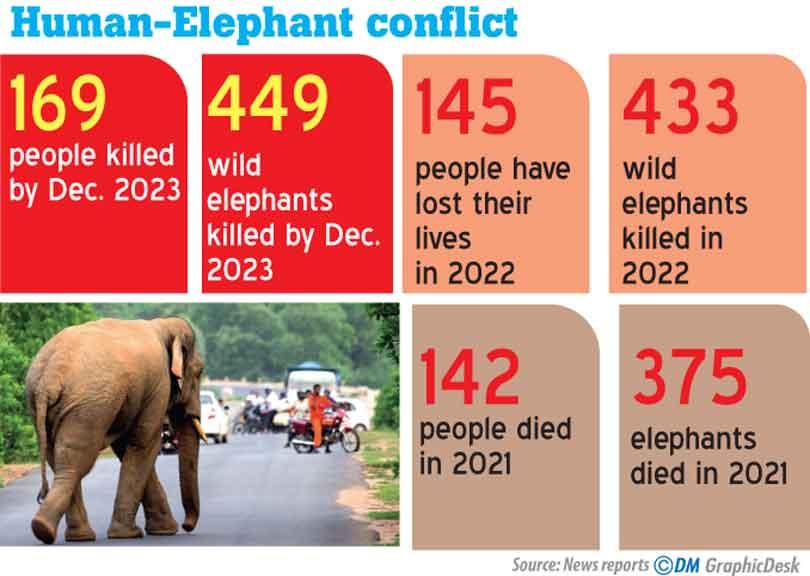05 Dec 2023 - {{hitsCtrl.values.hits}}
 By Kelum Bandara
By Kelum Bandara
With as many as 449 Wild Elephants and 169 people killed in the human-elephant conflict by December 1, this year, the relevant authorities are still at a loss to work out a practical solution to the problem.
According to the latest statistics released by the Department of Wildlife Conservation, gunshot injuries have claimed the lives of 81 Pachyderms. Besides, 60 jumbos perished due to electrocution. Hakka Patas (jaw bombs or explosive-laden bait) killed 44 elephants, train accidents 22, poisoning four, road accidents one and other forms of accidents 14. Four Elephants drowned after falling into agro-wells. The wildlife authorities cannot vouch for the reason for the remainder of Elephant deaths because carcasses have decomposed by the time of discoveries.
The Human-Elephant conflict is not a phenomenon that occurred in recent times. It has been going on for decades, but the intensity of the problems has increased by leaps and bounds due to enhanced encounters between people and elephants.
A 2019 study says that people live in nearly 70 per cent of the elephant range in Sri Lanka. It means people encounter elephants more frequently. The problem is severely found in the Anuradhapura, Polonnaruwa and Eastern Forest Ranges. With the latest statistics, this year appears to be the worst in terms of the number of deaths on both sides.
People expand further into wild space for agricultural activities, resulting in herds of Elephants marauding croplands at the end. Nutritious crops like maize, rice and bananas are enticing for gentle giants.
Farmers are used to install electric fences, but the solution has not yet been effective. Then President Gotabaya Rajapaksa formed a high-level committee consisting of experts from different fields who came up with a National Action Plan. This committee was headed by Elephant biologist Prithiviraj Fernando of the Centre for Conservation and Research (CCRSL), and submitted its report in December 2020.
Current President Ranil Wickremesinghe, has recently directed authorities to enact the action plan, in line with the elephant conservation policy adopted in 2006. An action plan is needed. In most regional countries afflicted with the Human–Elephant conflict, farmers use common tactics to drive away wild elephants from their lands, according to affected farmers.
According to the International Fund for Animal Welfare, Elephants are mega-herbivores that eat up to 150 kilograms of forage and drink up to 190 litres of water a day. It says they must navigate across large areas to find enough food and water to survive. But, the land is shrinking, making co-existence harder. An action plan has to be evolved with practical approaches, as otherwise both Humans and Elephants will continue to perish.

27 Jul 2024 10 minute ago
27 Jul 2024 3 hours ago
27 Jul 2024 4 hours ago
27 Jul 2024 6 hours ago
27 Jul 2024 7 hours ago